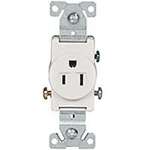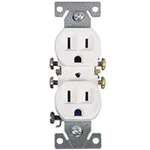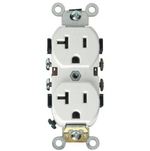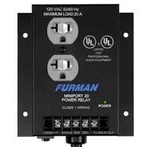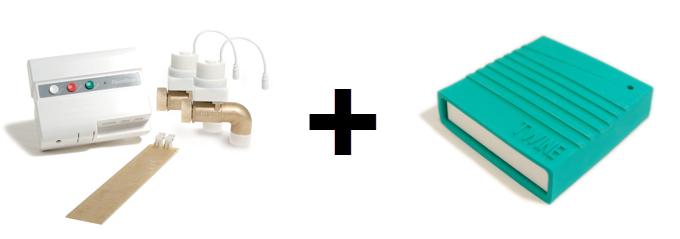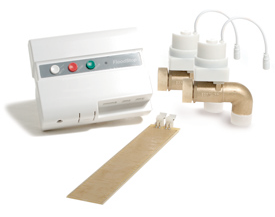 Have you ever experienced a flood in your home due to a faulty water supply line to your washing machine? The amount of devastation and damage can be well into the many thousands of dollars not to mention the time and inconvenience cleaning up the aftermath. Fortunately there are several detections systems on the market that can help prevent these type of catastrophes.
Have you ever experienced a flood in your home due to a faulty water supply line to your washing machine? The amount of devastation and damage can be well into the many thousands of dollars not to mention the time and inconvenience cleaning up the aftermath. Fortunately there are several detections systems on the market that can help prevent these type of catastrophes.
Unfortunately, I was not able to find a unit that met *all* my needs and concerns. So I found the next best thing .. a device with IO ports. The Floodstop Washing Machine Valve Shutoff Kit provides auxiliary IO (input-output) ports that enables you to extend the device's capabilities thru custom integration.
The Floodstop unit itself does provide a water sensor pad, a control unit, and the hot & cold water shut-off valves. It is designed to shut-off the water supply in the event that water is detected on the sensor pad which typically would be located on the floor behind the washing machine. You can also purchase additional sensors and daily chain them if you want to detect water in multiple locations. The Floodstop unit has worked really well for me and has passed nearly two years worth of testing in my home. The control unit seems to be built cheaply which is a downside, but it has worked flawlessly so I really can't complain too much.
Ok, so why is the design of the Floodstop no enough? Well if the supply lines are compromised, then you should be covered, but if the drainage line becomes disconnected, stopped up, or fails, then the Floodstop will shut off the water supply, but if your machine is running a cycle, it can pump the entire water contents of the tub out on your floor. (This very thing happened to a neighbor of mine.)
Here is where we really get started with this project.
I wanted to kill the power to the washing machine to (a) prevent it pumping water out if the drainage line is compromised and (b) prevent the washing machine from trying to run a cycle if the water supply has been cut off by the Floodstop to prevent any damage to the washing machine. Since the Floodstop provides both a NO (normally-open) and NC (normally-closed) contact leads, all I needed was to find a power controller that could be controlled via contact closure.
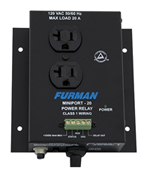 Enter the Furman MP-20 Power Relay Accessory. This is an industrial quality power controller and can handle electrical loads up to 20 amps. (Please see the addendum to this article at the bottom of the page for 15 amp circuits using the Furman MP-15) Perfect for my washing machine. Unfortunately the Furman it is a little pricey; however, I was able to pick up a slightly used unit on eBay at a very reasonble price. A second important feature of the Furman MP-20 is that it includes a low voltage (12 VDC) power supply built into the unit itself --- so no additional ugly and bulky wall warts to supply power for this low-voltage circuit.
Enter the Furman MP-20 Power Relay Accessory. This is an industrial quality power controller and can handle electrical loads up to 20 amps. (Please see the addendum to this article at the bottom of the page for 15 amp circuits using the Furman MP-15) Perfect for my washing machine. Unfortunately the Furman it is a little pricey; however, I was able to pick up a slightly used unit on eBay at a very reasonble price. A second important feature of the Furman MP-20 is that it includes a low voltage (12 VDC) power supply built into the unit itself --- so no additional ugly and bulky wall warts to supply power for this low-voltage circuit.

Locate the NO (normally-open) IO contacts on the Floodstop control unit. Please note that the instruction manual and diagram that came with the unit were wrong (at the time of this writing). I used a continuity tester to verify which port was which. When the Floodstop unit is running normally the NO contacts provide an open circuit and when water is detected and the Floodstop sounds its alarm and closes the water valves, it will also close the NO contacts thus allowing the completion of our trigger circuit.

On the Furman locate PIN 1 (+12 VDC) and PIN 3 (REM). These are the two pins that we will use with the Floodstop to control power to the outlet. When a circuit is completed between PIN 1 (+12 VDC) and PIN 3 (REM) the Furman will turn the power to the outlet off.
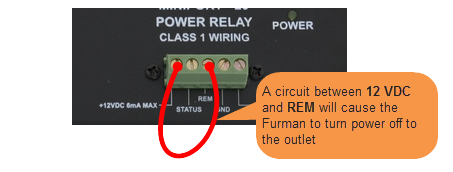
So all we need to do is wire the Floodstop NO (normally-open) pins to the Furman on PIN 1 (+12 VDC) and PIN 3 (REM). Thus when water is detected the Floodstop will close the NO circuit allowing the +12 VDC a complete circuit to the Furman's REM (remote) pin and subsequently will shut off the power. The diagram below shows the wiring connection. By the way, good news, the Floodstop does come with two short wires and connectors to interface to the Floodstop IO ports. We only need to use one of them.
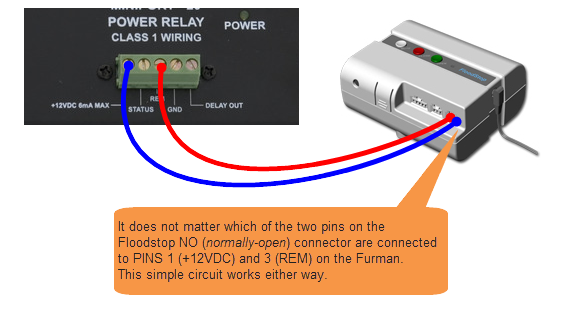
Now the setup is complete by installing all the equipment and plugging in the washing machine to the Furman outlet. The picture below is my complete installed system.
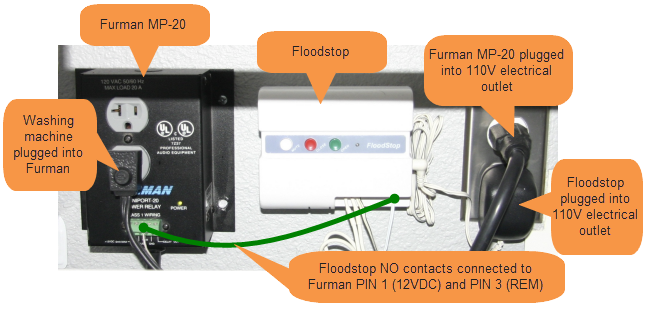
A few final words of caution. A few reviews for the Floodstop on Amazon report that the Floodstop unit quits working over a period of time and has failed to protect a few customers. I personally have not encountered any failures in the almost two years that I have had it installed. Just a few drops of water on the sensor pad and the Floodstop will come to life sound its alarm and shut-off both hot and cold water valves. I do perform routine tests of the system to ensure it continues to function properly and I would recommend that if you install a system like this that you do the same. It only take about two minutes to test it out.
When you install the Furman or other power controller, please don't leave it on the floor. Make sure to install it on the wall or at least place it on a shelf or somewhere where it would not be exposed to water in the event of a failure.
The Floodstop unit can be battery powered or plugged into the wall. Please plug it in and use the batteries as a back-up only. This whole system is vulnerable if it relies on being battery powered only.
There are alternatives to the Furman and you may be able to find a more economical option. I have seen an article where a similar setup was built using a X10 power controller. While I'm sure this will work just fine, I am reluctant to build a protection system that relies on either a wireless or powerline signal such as X10. Perhaps that is just me being over protective, but why take the chance?
Thank you and feel free to provide any comments questions and success stories.
 Robert Savage
Robert Savage
